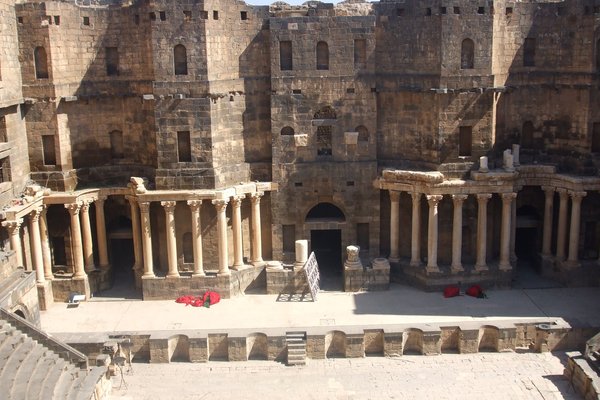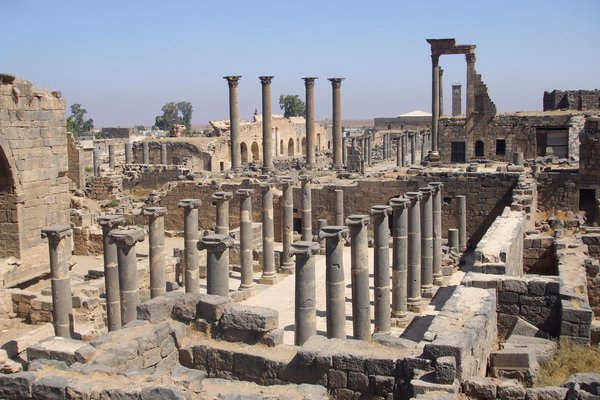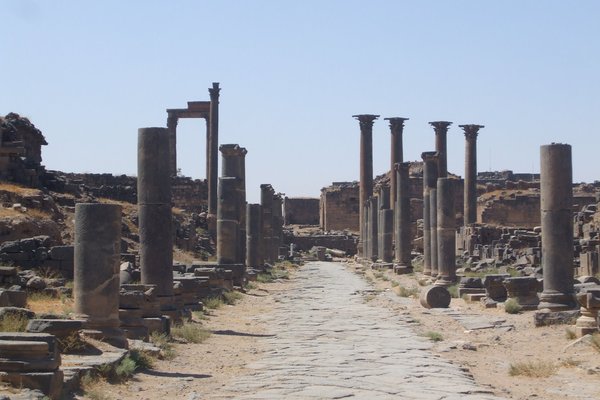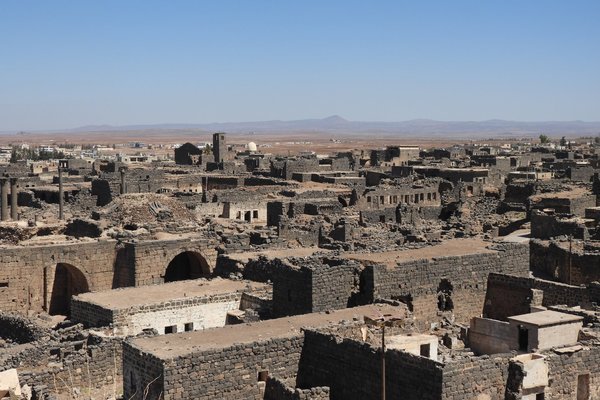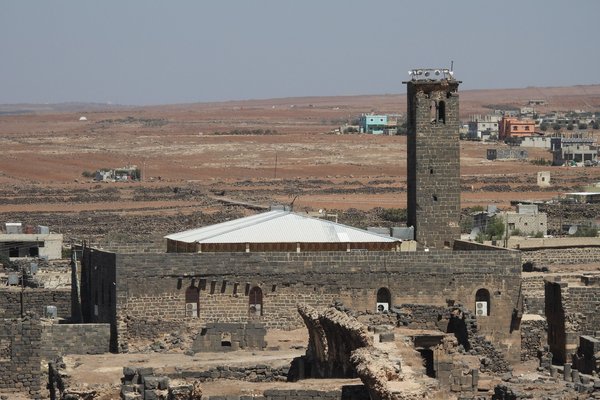Syria
Bosra
The Ancient City of Bosra holds extensive remains of Nabataean, Roman, Byzantine and Umayyad buildings.
As a Roman colony and a major place of trade along caravan routes, it gained many monuments such as the well-preserved theatre. In the Byzantine period, Bosra became the seat of an archbishop and a Cathedral was built. Bosra also is associated with a significant episode in the life of the Prophet Mohammed. Bosra’s Mosque of Omar and Madrasa Jâmi' Mabrak an-Nâqua are two of the rare constructions of early Islam preserved in Syria.
Community Perspective: Bosra is a town of black basalt and dust, and a little bit forgotten. The intermingling of ancient ruins and modern housing makes for an odd feeling. The huge Roman theatre is the main deal.
Site Info
Official Information
- Full Name
- Ancient City of Bosra (ID: 22)
- Country
- Syria
- Status
-
Inscribed 1980
Site history
History of Bosra
- 2017: Boundary change
- Increase of approximately 14% of the inscribed property, going from 4 to 2 components adding intermediate areas.
- 2013: In Danger
- Together with all 5 other Syrian WHS, due to Civil War
- 1980: Inscribed
- Inscribed
- 1979: Deferred
- Bureau - lack of documentation or Info
- 1978: Deferred
- In Danger
- Together with all 5 other Syrian WHS, due to Civil War Since 2013
- Type
- Cultural
- Criteria
- i
- iii
- vi
Links
- UNESCO
- whc.unesco.org
- Official
-
- homsonline.com — Bosra
All Links
UNESCO.org
- whc.unesco.org — whc.unesco.org/
Official Website
- homsonline.com — Bosra
News Article
- July 1, 2018 english.enabbaladi.net — Bosra Amphitheater: Syrian World Heritage Site Is Again Target for Shelling
- Dec. 25, 2015 aranews.net — UN condemns archaeological destruction at Bosra
- April 15, 2015 telegraph.co.uk — Damage to Roman mosaics and the ancient stonework at the site of Bosra
- Jan. 25, 2012 sana.sy — New Archeological Finds at Roman Bathhouses Site in Bosra
Travel Guides
- bosracity.com — Bosra City: In-depth history about the various ruins
Community Information
- Community Category
- Archaeological site: Ancient Rome
Travel Information
Red Zone Travel Advisory
Recent Connections
-
On Banknotes
Bosra Theatre on the 1000 Syrian Pound …
-
Nymphaeum
"Down from the theatre and the central …
-
Red Zone Travel Advisory
Syria fully off-limits
Connections of Bosra
- Individual People
-
-
Gertrude Bell
Photo taken May 1900 -
Ibn Battuta
"We marched to the town of Bosra, and thence to the castle of al-Karak."
-
- Geography
- Trivia
-
-
On Banknotes
Bosra Theatre on the 1000 Syrian Pound note (issued 2015-2024'
-
- History
-
-
Nabatean culture
"was a major Nabataean city in the 1st century CE, but was profoundly altered by the Roman and then Byzantine presence. The Nabataean vestiges are few in number,.." (AB ev Al Hijr) -
Umayyad Caliphate
OUV: "there remain today extensive ruins of Nabataean, Roman, Byzantine and Umayyad buildings". The latter included Al-Omari Mosque: is an early Islamic-era mosque. The mosque's square minaret was one of the earliest examples of Umayyad-style minarets (wiki) -
Ancient Roman colonies
Once the capital of the Roman province of Arabia Um er-Rasas (Kastrom Mefa'a)- started as a Roman military camp and grew to become a town from the 5th century -
Byzantine Empire and Civilization
extensive ruins of Nabataean, Roman, Byzantine and Umayyad buildings (OUV) -
Silk Roads
(Near) Classic Land Route; in ICOMOS thematic study but no details on role or function
-
- Architecture
-
-
Tetraconch
The ruined so-called Cathedral of Bosra, of the early 6th century, is the earliest major Syrian tetraconch church (wiki)
-
- Damaged
-
-
Damaged in War since WWII
Syrian Civil War "The ancient city of Bosra, located in the southern Daara governorate, contains ruined buildings from the Roman, Byzantine, and early Islamic periods. Between October 2009 and April 2014, a number of probable shell craters appeared within the site, including a hole in the roof of the Al-Omari Mosque."See www.bbc.co.uk
-
- World Heritage Process
-
-
Minor modifications after inscription
2017: Include Audion area, Martyrs graveyard area, Natural spring water area (addition of 14% to core zone) -
Inscribed at third attempt or more
Def 1978, Def 1979, Ins 1980
-
- Religion and Belief
-
-
Cathedrals
Cathedral of Bosra (former cath) -
Notable mosques
Mosque of Omar, one of the oldest surviving mosques in the world (720/1), built on the site of a pagan temple -
Nymphaeum
"Down from the theatre and the central arch, turn right along the decumanus, the eye is caught by a group of tall slender columns. The first four, set at an angle to the street, are supposed to be the only surviving elements of Nymphaeun." (source)
-
- Human Activity
-
-
Locations for playing sport
Roman circus
-
- Constructions
-
-
Theatres and Opera Houses
Roman theatre -
Roman amphitheatres
Roman amphitheatre
-
- WHS on Other Lists
-
-
World Monuments Watch (past)
(2004)
-
- Timeline
-
-
Built in the 6th century
Cathedral of Bosra was finished in 513; visit by the (later) prophet Muhammad (582) -
Built in the 2nd century
For its 2nd century Roman theatre
-
- Visiting conditions
-
-
Red Zone Travel Advisory
Syria fully off-limits
-
News
- english.enabbaladi.net 07/01/2018
- Bosra Amphitheater: Syrian World H…
- aranews.net 12/25/2015
- UN condemns archaeological destruc…
- telegraph.co.uk 04/15/2015
- Damage to Roman mosaics and the an…
Recent Visitors
Visitors of Bosra
- Adrian Turtschi
- Alexander Barabanov
- Alexander Lehmann
- Ali Zingstra
- Ammon Watkins
- Argo
- Aspasia
- Atila Ege
- Bill Maurmann
- Bram de Bruin
- Christian Wagner
- Delphine Delaunay
- Els Slots
- Erik Jelinek
- Eva Kisgyorgy
- Evgenii
- Fan Yibo
- Fmaiolo@yahoo.com
- Gernot
- Harry Mitsidis
- henryjiao18
- Iain Jackson
- Janos
- Jarek Pokrzywnicki
- Jonas Hagung
- Jon Opol
- Joyce van Soest
- Loic Pedras
- Lucio
- Malgorzata Kopczynska
- marcel staron
- Marcobrey
- Martin
- michaelsballard
- Miloš Tašković
- MoPython
- Morodhi
- Nihal Ege
- PeterH
- Philipp Leu
- pressdm
- Roger Ourset
- Roman Raab
- Solivagant
- Squiffy
- Stanislaw Warwas
- Szabolcs Mosonyi
- Szucs Tamas
- Thomas Buechler
- Timothy C Easton
- triath
- Westwards
Community Reviews
Show full reviews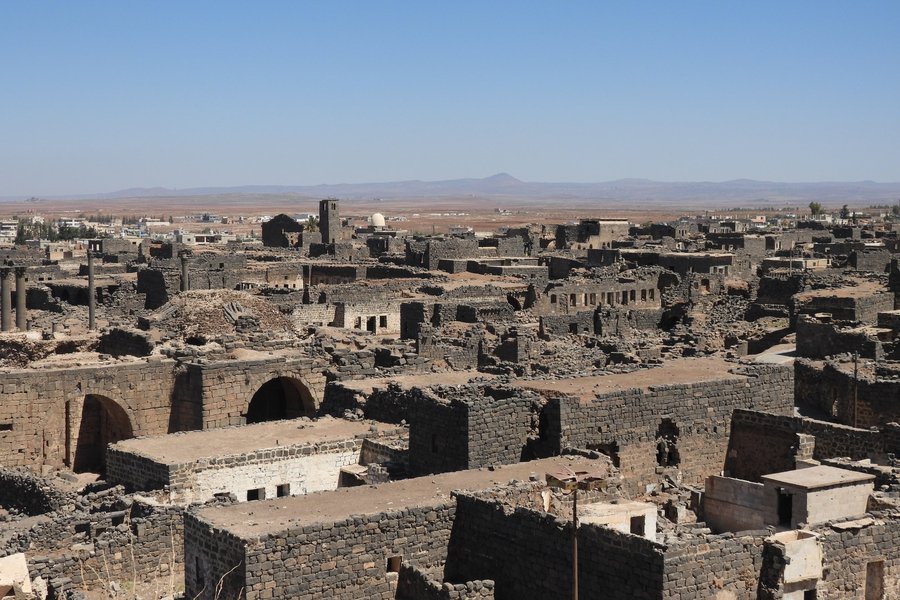
I was close to Bosra 5 months ago, when I visited Umm Al-Jimal. That Jordanian WHS lies just some 25km away and is said to have been within the sphere of influence of Bosra. However, although the two share the distinctive black basalt as the main building material, Bosra was clearly the more prominent city during the Roman and Byzantine eras.
We visited Bosra as a day trip from Damascus, the drive is just 1h45 minutes one way. It’s an easy turn-off from the strategic main road to Amman. In the distance, we could see the Druze city of Suwayda, the only place declared out of bounds during our trip due to fighting as recent as July 2025 (it wasn’t on the itinerary anyway). Everything was fine on the ground in Bosra, but some leftover graffitti here and there attested to the city’s prominent role in the toppling of the regime of Assad.
There is clearly an Old Town and a New Town in Bosra. We parked near the entrance of the citadel (yes, another one in Syria – they do castles well). This one, though, is the shell that encapsulates the great Roman Theater. It has been wonderfully preserved, including the stage, and is among the very best remaining of its kind. The grounds of the citadel also have some good mosaics and sculptures.
I had put some effort into adding Points of Interest to our Bosra site map, and managed to pinpoint almost all historic sights. Only …
Keep reading 0 comments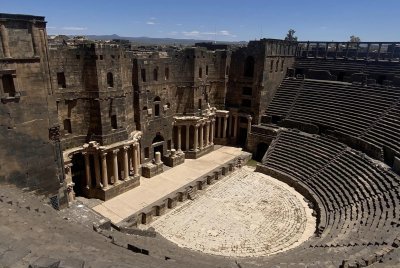
Visited on a group tour to Syria in May 2023.
Although the city is controlled by the Free Syrian Army, but there are mutual agreements, and foreign tourists are brought here from the territories controlled by Assad. Everyone needs money.I really wanted to visit this city, because it is the last capital of the Nabataean kingdom, and after visiting Petra it was logical to get here as well, although there is little left of the Nabataeans here, only a huge gate, the same type as in Petra.In fact, the Romans built a new city here, which became the capital of the province of Arabia.The most important building of the Roman era can is the well-preserved Roman theater, although it is not so big (about 8 thousand spectators), but the stage and the rows of spectators have perfectly survived to our time. Maybe because basalt was used as the main building material, and the Muslims rebuilt the theater into a citadel after conquering the city, thus preserving it.There are also traces of the Byzantine era, a basilica that was the center of the bishopric. From Islamic times, the main object is the Omar's Mosque, it claims the status of one of the first mosques in the world according to local tradition, although historians have doubts about this.In general, there are many different layers, but it looks complete, because the material is the same - basalt, and the architectural continuity is visible.
Keep reading 0 comments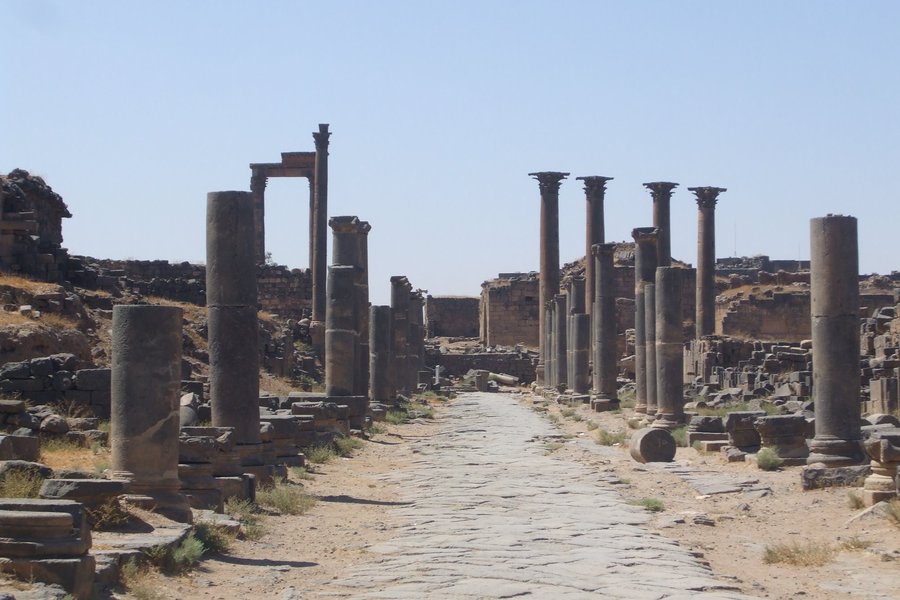
The old sunken roadway still held its north-south bearing. The stubby remains of columns lined my way to left and right as I walked, my feet kicking up puffs of sand from the stone flags. I could feel the heat of the morning through the soles of my shoes. Towards me swayed an old woman in a startling midnight blue velvet robe, a black plastic sack balanced on her head. Two schoolboys ran past, late for class. I stopped in disbelief before a pair of skyscraping Roman columns. It was not the columns themselves or the finely decorated architrave that startled me. Instead it was the fact that rough hunks of dark masonry had been used to fill in the lower half of the gap between them. Doors and barred windows glowered at me. These Roman ruins, out on the edge of empire, were still inhabited to this day.
Bosra is a town of black basalt and dust. Even when I visited in 2009, ten years ago, it seemed a little bit forgotten. The tour buses charged straight on from the Jordanian border for the orientalist allure of Damascus. No one turned right to follow the road to Bosra. And that was a shame. The town was definitely of interest. Bosra has a long and storied history, passing from one conquering empire to another like a family heirloom. Nabateans to Romans, Romans to Byzantines, Byzantines to Sassanians and back again before falling to the first caliphate just two years after …
Keep reading 0 comments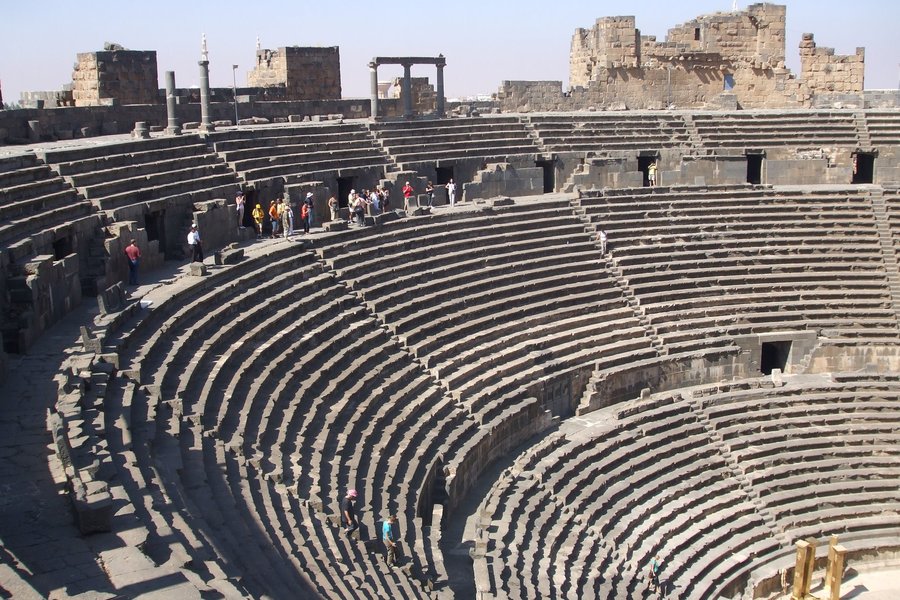
Great drive from Damascus to Bosra, really enjoyed it some interesting places to stop and eat. The Theatre was interesting, the basalt rock used to construct it seems indestructible. Not much else to see in the town though. It seems it later became a fort to defend the city.
Keep reading 0 comments
Paul Tanner's review is quite accurate. The intermingling of ancient ruins and modern housing makes for an odd feeling. Unfortunately some of the shells of ancient buildings have been used as garbage dumps by the residents. Walking down the streets you can come across the ruins of unexcavated ancient buildings in whose debris you can see fragments of Roman glass protruding. Besides the excelently preserved Roman theater, the site is notable for the use of black basalt stonework. It is so very different from the usual marble. There is so much still standing that a conservation program that includes relocating the current residents could make for a wonderful archaeological park.
Keep reading 0 comments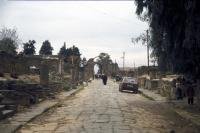
Bosra is a very strange “ruined town”. Its remains are primarily Roman and its star attraction is the well preserved 15000 seat Roman theatre. What is slightly disconcerting when visiting the place is the intermingling of current dwellings and ruins. People live inside the city walls in houses which either are or are partly built from or are next to “old” buildings. The streets still seem to be paved as in Roman days – yet have clapped out old cars parked in them (photo!).
The city is located south of Damascus close to the Jordanian border in an area you are unlikely to visit to see anything else and, in my view is only worth a visit if you can either
a. take it in if crossing at Dera to/from Jordan
b. are determined to pick up all the Syrian WHS!!
Keep reading 0 comments
the great thing about this City is the fact that it survived about 2500 years inhabited and almost intact.the Romans, Nabateans, Byzanthine, Umayyad Muslims all left traces in it..it is simply an open museum. make sure to read about it before visiting or at least get a guide book to the numerous sites you are about to see or you will be lost and not really appreciate what you are seeing.
you might wanna know how important it is to the Eastern Christians since it was a center of archbichop and it has many intact ancient churches. alo very important for muslims since in it prophet Mohammed has met the monk Buheira who was the first to forsee the child Mohammad's prophesy. It was also the second Nabatean capital after the sacking of Petra by the Romans.
truely a must see if you are spending longer than a few days in Syria.the area also has many other ancient classic cities like Shahba, Qanata(Qanawat),Izraa, Salkhad..etc
Keep reading 0 comments
